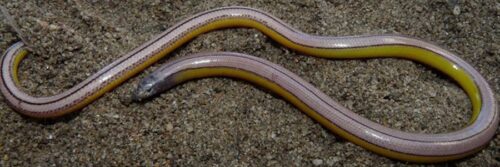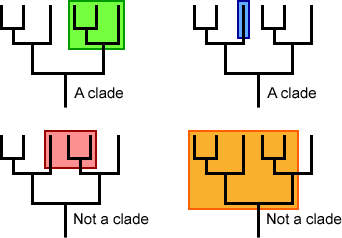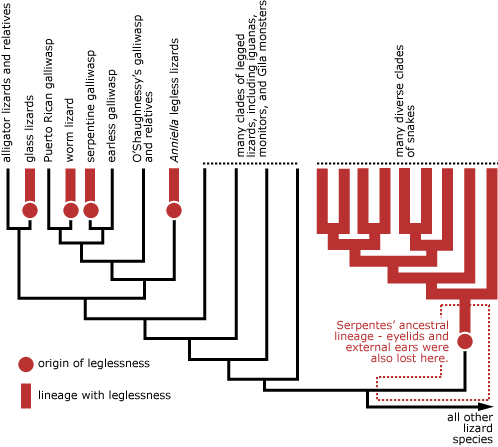
Last month, biologists announced the discovery of four new species of lizard, not in an exotic tropical jungle, but right under our noses. The new-to-science animals (from the genus Anniella) were found at several unlikely locations — including in an abandoned lot in Bakersfield, California, and near the runway at Los Angeles International Airport. But don’t count on catching sight of one of these critters the next time you have a layover at LAX. First, they are small — less than 8 inches long. Second, they live mostly underground (the researchers had to tempt them out of hiding by leaving pieces of cardboard and plywood on the ground). And third, even if you did see one, you might not recognize it as a lizard. The four new species have no legs and could easily be mistaken for snakes! So why aren’t these sleek, scaled creatures snakes, and how did they avoid detection for so long? The answers are evolutionary ones …
Where's the evolution?
Just as all that glimmers is not gold, all that slithers is not snake. That’s because biologists name organisms according to their evolutionary history. Only clades — groups that include all and only the lineages descended from one ancestral lineage — are given formal scientific names. The name snake corresponds with one particular lizard clade: Serpentes.
So snakes are simply a clade of legless lizards. And while Serpentes is the largest and most diverse of these clades, it is certainly not the only one. Leglessness has evolved in more than 20 other clades of lizards! The tree below shows just a few of these clades, including that of the newly discovered species, the genus Anniella.
In the lizard lineage that begot Serpentes (marked on the phylogeny above), legs (as well as eyelids and external ears) were lost. To find out if a legless lizard is a snake, just look for a lack of eyelids and external ears. Snakes are unique in having inherited these traits from their common ancestor. However, it’s important to remember that what really makes a particular legless lizard a snake is where on the tree of life its lineage connects, not which particular physical characteristics it has. If, through some twist of fate (and many, many generations of evolutionary change), legs and external ears should evolve in a snake lineage, that lineage would still be a member of the clade Serpentes and so would still be a snake! When it comes to biological names, you just can’t leave your past behind.
Though the new lizard species look a lot like snakes to the casual observer, any herpetologist (a biologist who studies reptiles) would easily recognize these critters as legless lizards — and herpetologists have been studying California’s biodiversity for more than a hundred years … so how did these four new species evade detection for so long? Biologists have long known that a species of legless lizard lives in California — Anniella pulchra — but when herpetologists James Parham and Theodore Papenfuss began to study the genes of that species, the found a lot more diversity than they expected. And this diversity wasn’t random. Lizards collected from the same regions tended to have similar genetic sequences, and the differences between lizards fell out into neat groups. These differences were so significant that they implied reproductive isolation between five major groups of the lizards and that the groups are distinct species.
To investigate, the two biologists studied the lizards in more detail, trying to identify differences in physical traits (i.e., morphology) that correspond with the genetic divides. Four of the lineages could be readily distinguished from one another by morphological traits (e.g., the lineage now known as A. alexanderae has a light gray belly, while the lineage designated as the originally named species, A. pulchra, has a yellowish belly). One of the lineages, A. stebbinsi, turned out to be a cryptic species — a species that is not possible to distinguish from others based on morphology alone.
Physical traits help us describe species, but they do not define them. Though the legless lizard species all look quite similar to one another (even the differences among the non-cryptic Anniella species are subtle), their genes reveal that they are on separate evolutionary trajectories, as reflected in the phylogeny below — and that is what matters in determining species boundaries. Species are defined based not on their appearance, but on deeper evolutionary issues: Do the organisms represent discrete evolutionary units? Are there barriers that would prevent them from interbreeding and easily collapsing back into a single lineage? Do their genes reflect these lineage splits? For these slithery non-snakes, the answer appears to be yes.
Primary literature:
- Parham, J. F., and Papenfuss, T. J. (2009). High genetic diversity among fossorial lizard populations (Anniella pulchra) in a rapidly developing landscape (Central California). Conservation Genetics. 10: 169-176. Read it »
- Papenfuss, T. J., and Parham, J. F. (2013). Four new species of California legless lizards (Anniella). Breviora. 536: 1-17. Read it »
- Wiens, J. J., Brandley, M. C., and Reeder, T. W. (2006). Why does a trait evolve multiple times within a clade? Repeated evolution of snakelike body form in squamate reptiles. Evolution. 60: 123-141. Read it »
News articles:
- A brief report on the discovery from the Los Angeles Times
- A thorough review of the research from SFGate
Understanding Evolution resources:
- Why aren’t the legless lizards described above classified as snakes?
- Identify three different clades on the lizard phylogeny in the article above. You may do this by sketching the phylogeny and circling the clades or by listing the modern organisms included in each clade.
- On the lizard phylogeny in the article above, how many times does leglessness evolve?
- Read about the biological species concept and other species concepts. Which species concept do Parham and Papenfuss seem to be using? Explain your reasoning.
- Advanced: Read this page about the biological species concept. Do Parham and Papenfuss seem to be using the biological species concept? Why or why not? Is there any evidence that might support the idea that the five Anniella species meet the requirements of the biological species concept? If so, what is the evidence?
- Advanced: Read this page about other species concepts. For each species concept, describe any evidence that might support the idea that the five Anniella species qualify as separate species according to that species concept.
- Teach about evolutionary trees: In this web-based module for grades 6-12, students are introduced to cladistics, which organizes living things by common ancestry and evolutionary relationships.
- Teach about classification and convergent evolution: In this news brief for grades 9-16, students learn about the discovery of a new mammal species, a giant elephant shrew. Though elephant shrews resemble regular shrews, recent genetic evidence suggests that elephant shrews actually sprang from a much older branch of the tree of life.
- Teach about gene-based phylogenies: In this lesson for grade 9-12, students explore molecular data from Homo sapiens and four related primates and develop hypotheses regarding the ancestry of these five species by analyzing DNA sequences, protein sequences, and chromosomal maps.
- Netburn, D. (2013). Four new legless lizard species discovered in California. Los Angeles Times. Retrieved October 6, 2013 from the Los Angeles Times (http://articles.latimes.com/2013/sep/22/local/la-me-legless-lizard-20130923).
- Parham, J. F., and Papenfuss, T. J. (2009). High genetic diversity among fossorial lizard populations (Anniella pulchra) in a rapidly developing landscape (Central California). Conservation Genetics. 10: 169-176.
- Papenfuss, T. J., and Parham, J. F. (2013). Four new species of California legless lizards (Anniella). Breviora. 536: 1-17.
- Wiens, J. J., Brandley, M. C., and Reeder, T. W. (2006). Why does a trait evolve multiple times within a clade? Repeated evolution of snakelike body form in squamate reptiles. Evolution. 60: 123-141.



